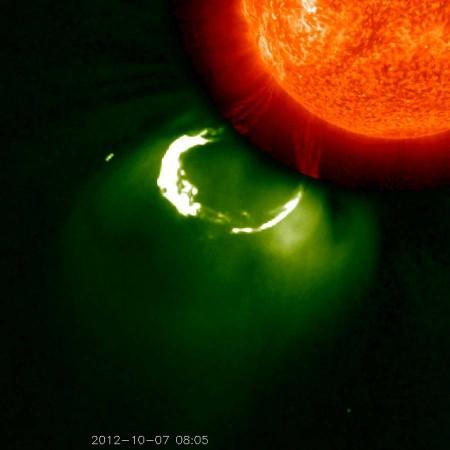Solar storms are set to release clouds of charged particles towards Earth, causing geomagnetic storms today, reveals sun-monitoring data.
Geomagnetic storms change Earth's magnetic field interacting with its atmosphere with charge particles from the sun. In case they are strong, these storms can cisrupt communication networks and even the power grids.
However, today's storm is expected to be of G1-class, according to the National Oceanic and Atmospheric Administration's Space Weather Prediction Center (SWPC) space weather scale, which may cause weak power grid fluctuations and have a minor impact on satellite operations.

As per the SWPC latest alert issue at 0655 UTC, Jul 19, 2022 the flare is of Geomagnetic K-index of 4 with Impact Area primarily poleward of 65 degrees Geomagnetic Latitude. It may "cause weak power grid fluctuations and Aurora may be visible at high latitudes such as Canada and Alaska."
Solar wind
speed: 484.2 km/sec
density: 11.10 protons/cm3
Updated: Tuesday at 0850
UTX-ray Solar Flares
6-hr max: C2 0429 UT Jul19
24-hr: C3 2354 UT Jul18
Updated: Today at: 0855 UT
Alongside the auroras, these storms may be visible in the sky in lower latitudes in Canada and the United States, especially in northern Michigan and Maine, SWPC said.
Space observers said the storm could have been caused by a cloud of particles ejected from "an unstable filament of magnetism" on the sun on July 15, and reaching Earth's atmosphere between July 19 and July 21.
Already, solar physicist Tamitha Skov had tweeted a NASA prediction model two days ago stating that it could be a "direct hit" from a July 15 solar ejection and the impact date would be on July 19. NASA has also released a video from its Solar Dynamics Observatory showing a flash of material racing away from the sun's surface in the mid-afternoon.
Direct Hit! A snake-like filament launched as a big #solarstorm while in the Earth-strike zone. NASA predicts impact early July 19. Strong #aurora shows possible with this one, deep into mid-latitudes. Amateur #radio & #GPS users expect signal disruptions on Earth's nightside. pic.twitter.com/7FHgS63xiU
— Dr. Tamitha Skov (@TamithaSkov) July 16, 2022
Known as coronal mass ejections (CMEs), these solar particles a common phenomenon on Sun at least twice a month. These CMEs carry billions of tons of material from the sun's atmosphere and carry an embedded magnetic field.

Some of them are capable of reaching Earth in as little as 15 to 18 hours but the July 15 solar flare is slower going by its hit date today, July 19 or July 20. Since today's impact is far less, the SWPC had not issued any warnings.













